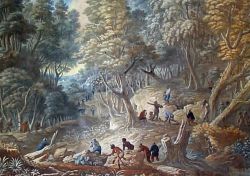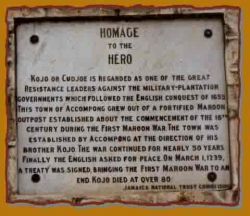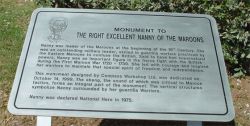Toronto Media Co-op
Local Independent News
The Jamaican Maroons: Freedom fighters or agents of slavery?
By Ajamu Nangwaya
The Jamaican Maroons are praised for winning their freedom through the use of guerrilla warfare. However, Afrikans tend to not betray an awareness of the Maroons as collaborators with slavery and colonialism.
The Jamaican Maroons established organized free communities with governance structures, means of providing for their basic needs, initiating new members into society, training the children and adults in the fighting arts and establishing codes of conduct. These self-liberated Afrikans also initiated raids against the plantation to acquire guns, gun powder, ammunition, supplies, food and animals, get revenge against Whites, and free enslaved Afrikans.
They had no fear of the enslavers and this behaviour could not have been seen as a good thing in a system that cultivated fear of the master. The Jamaican Maroons were seen as role models of freedom by enslaved Afrikans, that is “Up until the peace treaties with the colonial rulers, which was to alter the relations between free and unfree [B]lacks fundamentally” according to Werner Zips in his book Black Rebels: African Caribbean Freedom Fighter in Jamaica.
The record of the Jamaican Maroons’ fighting prowess and strategic and tactical capabilities in fighting the island’s militia and professional soldiers is confirmed by the historical record. The Maroon were skilled practitioners of guerilla warfare against the Spanish. Furthermore, from the moment of Britain’s capture of Jamaica from Spain in 1655 and the latter’s eventual acceptance of defeat in 1660, the Maroons were a source of threat to the new masters of the island.
In the text The Maroons of Jamaica, 1655–1796: A History of Resistance, Collaboration & Betrayal, the author, Mavis Campbell quotes Major Sedgwicke’s report on the Maroons’ retaliatory action for the killing of seven or eight of their comrades in April 1655: “In two daies (sic) more than forty of our soldiers, were cut off by Negroes, as they were carelessly going about their quarters.” The Maroons were seen a barrier to the colonization plan of the British and they sought ways to deal with these emancipated Afrikans. Campbell highlights the chief concern about the Maroons by Major Sedgwicke in a March 1655 or 1656 dispatch to Oliver Cromwell, [T]heir is a work we are now striving to effect for be assured they must be destroyed or brought in upon some terms or other or else they will be a great discouragement to the settling of people here.”
The planters and colonial authority from the mid-17th century to the first few decades of the 18th century had failed to contain the military initiatives and resistance of the Maroons. They offered rewards to free and enslaved Afrikans (the Black Shots), provided financial incentives to settlers for killing, capturing or simply chasing Maroons, imported Miskito Indians from Honduras to serve as trackers and deployed British soldiers and militia units with no appreciable success against the Jamaican Maroons. According to Zips, “After all attempts to eradicate [B]lack communities had failed, only peace negotiations with the [B]lack rebels would avert the threat to the system.”
The treaties of 1739 between the Jamaican Maroons and the British authority are the basis on which one may see the former as collaborators with the system of slavery and colonialism. Interestingly, the British won at the bargaining table goals that proved elusive on the battlefield. In Campbell’s The Maroons of Jamaica, she concludes that the mere signing of a treaty was a historic “triumph for the Maroons.” However, she also asserts that “in practical terms, though, it is another matter, for the Treaty, in effect, represents more a victory for the colonial powers than for the Maroons, who were never defeated in battle by the British.”
An examination of the first treaty that was signed by Captain Cudjoe and the British in 1739 would lead a reasonable person to conclude that the Jamaican Maroons became agents of slavery and colonialism. Clause 5 called on the Leeward Maroons to fight with the British in the event of an invasion of the Jamaica. Therefore, enslaved Afrikans would find it difficult to use the context of an invasion or intra-imperialist conflict to make a strike for freedom.
Clause 6 of the treaty obligated Cudjoe and his successors to “use their best Endeavours to take, kill, suppress or destroy, either, by themselves or jointly… all Rebels wheresoever they be throughout the Island, unless they submit to the same Terms of Accommodations granted captain Cudjoe, and his Successors.” Cudjoe would have had to take up arms against other Maroon communities that did not sign treaties with the slavery regime.
Clause 9 was very problematic given the quest for freedom being the motivating reason for the existence of the Maroons. This clause states that “if any Negroes shall hereafter run away from their Masters or Owners, and fall into Captain Cudjoe’s Hands, they shall immediately be sent back to the Chief Magistrate of the next Parish where they are taken; and those that bring them are to be satisfied for their Trouble, as the Legislature shall appoint.” The Maroons were given the proverbial “thirty pieces of silver” for exerting the effort in returning runaway Afrikans to slavery.
Clause 10 states that “All Negroes taken since the raising of this party by Captain Cudjoe’s people shall be immediately returned.” The Maroons clause did not hold freedom for all, especially for enslaved Afrikans, as a universal and non-negotiable principle.
Overall, Campbell asserts that “Clause by clause, the treaty favoured the colonial authority and the local plantocracy.” Zip is critical of researchers who ignore the complexity of the Maroons’ situation and instead “In chapter after chapter in their books, heroic revolutionaries are turned into traitors to their sisters and brothers on the plantation.” Yet it is hard to refute the evidence of history on the collaboration of the Maroons in undermining the armed resistance initiatives of enslaved or emancipated Afrikans. Zip comes across as an apologist for the Jamaican Maroons.
In the major insurrection of April 1760, Tacky’s Rebellion, by enslaved Afrikans in Jamaica, three companies of Jamaican Maroons gave their service to the British in defeating this uprising. The Maroons were compensated for killing or capturing the rebels or freedom fighters. These Maroon mercenaries were also given 7 pence and 1 half-penny per day for service rendered in hunting Tacky, the rebel’s leader, and his comrades in their bid for emancipation. The colonial regime gave 2 shillings and 6 pence to the Maroon officers. A Scott’s Hall Maroon named Lieutenant Davy was credited with killing Tacky and cutting off his head.
In the 1831-1832 Emancipation Rebellion in western Jamaica, the Accompong Maroons in St. Elizabeth did not acquit themselves in an admirable manner. Sam Sharpe, the leader of the uprising and a current Jamaican national hero, send two envoys to the Maroons seeking their participation in this fight to end slavery in Jamaica. According to Richard Hart, the Maroons “refused to participate in the rebellion. They arrested the emissaries and turned them over to the St. Elizabeth Militia.” The Maroon went beyond turning over the two rebels to the plantocracy. In the book ‘The Killing Time’: The Morant Bay Rebellion in Jamaica, the author Gad Heuman states that “A white man, [Colonel Alexander] Fyfe had led the Maroons in helping to suppress the 1831-2 slave rebellion and was a highly respected figure among them.”
The act of fighting on the side of the British to preserve slavery is not what we would expect from “heroic revolutionaries.” Zip acknowledges the negative role of the Maroons during the Emancipation Rebellion: “Once again during Jamaica’s largest slave revolt in [1831-]1832, in which 20,000 slaves participated, the mercenary services of the Maroons turned the scales, thus quelling the insurrection and causing emancipation to be postponed for another two years." It is the insurgents of Emancipation Rebellion who ought to be seen as heroic figures. They fought for the freedom of all and gave their lives to the cause of liberation. As a result of their insurrection, the British parliament was forced to grant emancipation-from-above by passing The Slavery Abolition Act of 1833. This piece of legislation formally abolished slavery in 1834 throughout the British Empire and, possibly staved off a Haiti-like emancipation-from-below.
In the post-Emancipation period, the labouring classes in Jamaica continued its tradition of resisting oppression by the use of uprisings, while the Maroons demonstrated their consistency in siding with the colonial regime. In October 1865, Paul Bogle, now a National Hero in Jamaica, led an armed revolt against the economic and political exploitation of Afrikan-Jamaicans by the white establishment. This resistance to oppression is now known as the Morant Bay Rebellion. The Maroons were provided with weapons and ammunition by the colonial authority and they viciously helped in putting down this rebellion.
The Maroons engaged in the summary killing of non-combatants and burning the houses of terrified Afrikan-Jamaicans. These Afrikan collaborators also carried out other activities such as protecting white settlements and properties, arresting suspects, trying accused prisoners for insurgency-related acts, and transporting suspects of major crimes to Morant Bay. On 23 October 1865, a group of Maroons captured Paul Bogle who was later hanged for his leadership of the uprising. The Maroons enthusiastically and callously participated in the colonial master’s scheme to put an end to the fight for self-determination by the exploited Afrikan population.
The Jamaican Maroons fought for their freedom from enslavement but their actions made it clear that they had a provincial or parochial view of Afrikan emancipation. They were freedom fighters in this limited sense. But from the perspective of runaway enslaved Afrikans who were returned to the plantation as well as those whose rebellions were crushed by the Maroons, they could only have been seen as collaborators or agents of slavery in Jamaica. Based on the experience of the rebels in the Morant Bay Rebellion and the non-participants who were victimized by the Maroons, the latter were traitors to the cause of Afrikan liberation.
Ajamu Nangwaya, Ph.D., is an educator, organizer and writer. He is an organizer with the Network for the Elimination of Police Violence.
About the poster
The site for the Toronto local of The Media Co-op has been archived and will no longer be updated. Please visit the main Media Co-op website to learn more about the organization.


